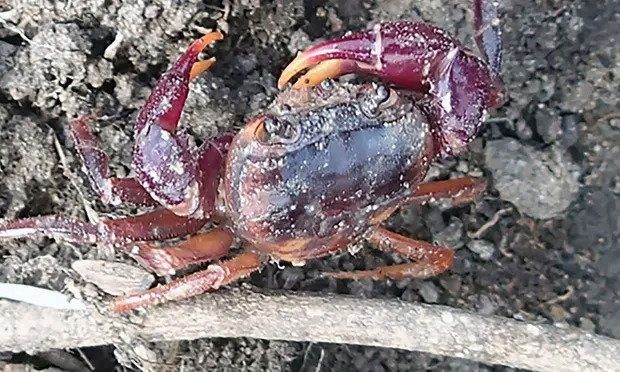There were no clues other than the label of a specimen of Afzelius crab with just two words: “Sierra Leone”. A research team has discovered this ultra-rare freshwater crab after 225 years.
Searching for rare, nearly extinct species has never been an easy task.
In January 2021, Pierre A Mvogo Ndongo traveled to Sierra Leone to find a super-rare land crab that had almost been forgotten. One of these is the Afzelius crab (Afrithelphusa afzelii), which was last seen in 1796.

Afzelius crab, one of the species discovered for the first time since 1796. (Photo: Pierre A Mvogo Ndongo/re:wild).
Ultra-Rare Crab Species
Mvogo Ndongo’s expedition primarily aimed to search for the Sierra Leone land crab, a rainbow-colored species known as Afrithelphusa leonensis. This crab has been missing for 65 years and is considered extinct, listed as one of the “25 most critically endangered species” by the Re:wild organization.
His other hope was to find the Afzelius crab (Afrithelphusa afzelii).
Both crab species are terrestrial, living in burrows in tropical forest floors. Mvogo Ndongo, a lecturer at the Institute of Fisheries and Aquatic Sciences at the University of Douala in Cameroon, stated: “Most freshwater crabs in Africa live in rivers, streams, and lakes.”
“This rare crab belongs to a unique Afrotropical family, capable of breathing air, which allows them to adapt to harsh tropical forest habitats often far from water sources. They are much more colorful compared to other terrestrial crabs, can climb trees, live in crevices, and dig burrows in swamps or under forest floors,” he analyzed.
He noted that Sierra Leone, Guinea, and Liberia are the only three countries in Africa where this crab species is found and that only five species are known.
After three weeks of working with local communities in Northern, Southern, and Southeastern Sierra Leone, Mvogo Ndongo found no clues and felt hopeless.
Typically, scientific discoveries are often based on prior clues from previous explorers. However, in this case, Mvogo Ndongo had nothing to go on.
“For 225 years, no one has seen Afrithelphusa afzelii; the only information about them is a specimen label named ‘Sierra Leone’ – indeed a rather vague location. We inferred that it had been collected within walking distance from Freetown, so we began surveying in the nearby forest. Still, everything remained too vague,” he said.

Sierra Leone crab is one of the “25 most critically endangered species” by Re:wild. (Photo: Re:wild).
Deep in the Burrows
The research team surveyed local residents to see if they had spotted any land crabs far from rivers or streams. Eventually, a man led them to his farm at the forest edge, where they found them.
One day after discovering the Afzelius crab, Mvogo Ndongo went to the Sugar Loaf Mountain forest, south of Freetown. With time limited due to an impending Covid-19 lockdown, he scoured the Guma Lake area for searches.
It was not until he ventured deep into the forest that he found the rare crab. They lived in such deep burrows that Mvogo Ndongo’s team had to carefully excavate them with hoes and machetes, before cleaning the dirt off their bodies, revealing colorful shell fragments. These are considered the first live specimens seen since 1955.
Together with the Sierra Leone crab and the Afzelius crab rediscovered, they also found two new freshwater crab species. However, the habitat of these crabs is threatened by deforestation for agriculture and firewood.
“We are happy to have discovered species thought to be lost, but saddened that they are on the brink of extinction and require urgent intervention measures for long-term protection,” said Neil Cumberlidge, a professor of Biology at Northern Michigan University, who collaborated with Mvogo Ndongo on the expedition.
Now that the crabs’ habitats are known, scientists hope they will be protected.
Cumberlidge stated: “New data allows us to reassess the red list status of each species in this group, and this species may be classified as ‘critically endangered,’ meaning it is close to extinction,” he said.
“The next step will be to develop an action plan for them and implement on-site protection measures with Sierra Leone conservationists to save these crab species from extinction risks,” he added.





















































